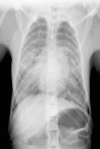Acute respiratory distress syndrome in two rhesus macaques (Macaca mulatta)
- PMID: 18947174
- PMCID: PMC2691537
Acute respiratory distress syndrome in two rhesus macaques (Macaca mulatta)
Abstract
Acute respiratory distress syndrome (ARDS) is an important and potentially life-threatening complication in humans that arises subsequent to a variety of primary insults including noxious fume inhalation, infection, and trauma. Here we describe the first two cases of ARDS reported in association with postoperative complications in rhesus macaques. In agreement with the multifactorial nature of the human syndrome, ARDS in one monkey was attributed to sepsis, whereas in the other it was ascribed to neurogenic trauma. Despite the different etiologies, both monkeys demonstrated clinical features of ARDS, including progressive dyspnea and pulmonary edema, and syndrome-defining histopathologic criteria including edema with intraalveolar neutrophils, fibrinohemorrhagic effusions with crescentic membranes, and interstitial vascular degeneration. Recognition and aggressive treatment of ARDS at an early stage may improve survival rates in dyspneic nonhuman primates with underlying extrapulmonary diseases.
Figures


Similar articles
-
Resuscitation before stabilization of femoral fractures limits acute respiratory distress syndrome in patients with multiple traumatic injuries despite low use of damage control orthopedics.J Trauma. 2009 Nov;67(5):1013-21. doi: 10.1097/TA.0b013e3181b890be. J Trauma. 2009. PMID: 19901662
-
Pulmonary and extrapulmonary forms of acute respiratory distress syndrome.Semin Respir Crit Care Med. 2001 Jun;22(3):259-68. doi: 10.1055/s-2001-15783. Semin Respir Crit Care Med. 2001. PMID: 16088678
-
Drug-induced pulmonary edema and acute respiratory distress syndrome.Clin Chest Med. 2004 Mar;25(1):95-104. doi: 10.1016/S0272-5231(03)00128-X. Clin Chest Med. 2004. PMID: 15062601 Review.
-
Postoperative acute respiratory distress syndrome development in the thoracic surgery patient.Semin Thorac Cardiovasc Surg. 2006 Spring;18(1):28-34. doi: 10.1053/j.semtcvs.2005.12.002. Semin Thorac Cardiovasc Surg. 2006. PMID: 16766250 Review.
-
Acute respiratory distress syndrome in Plasmodium vivax malaria: case report and review of the literature.Trans R Soc Trop Med Hyg. 2007 Jul;101(7):655-9. doi: 10.1016/j.trstmh.2007.02.014. Epub 2007 Apr 12. Trans R Soc Trop Med Hyg. 2007. PMID: 17433389 Review.
Cited by
-
Pre-existing immunity does not impair the engraftment of CRISPR-Cas9-edited cells in rhesus macaques conditioned with busulfan or radiation.Mol Ther Methods Clin Dev. 2023 Apr 20;29:483-493. doi: 10.1016/j.omtm.2023.04.004. eCollection 2023 Jun 8. Mol Ther Methods Clin Dev. 2023. PMID: 37273902 Free PMC article.
-
Characterization of Multi-Drug Resistant Enterococcus faecalis Isolated from Cephalic Recording Chambers in Research Macaques (Macaca spp.).PLoS One. 2017 Jan 12;12(1):e0169293. doi: 10.1371/journal.pone.0169293. eCollection 2017. PLoS One. 2017. PMID: 28081148 Free PMC article.
-
Analgesic use in nonhuman primates undergoing neurosurgical procedures.J Am Assoc Lab Anim Sci. 2013 Jan;52(1):10-6. J Am Assoc Lab Anim Sci. 2013. PMID: 23562027 Free PMC article. Review.
References
-
- Bergin IL, Chien CC, Marini RP, Fox JG. 2000. Isolation and characterization of Corynebacterium ulcerans from cephalic implants in macaques. Comp Med 50:530–535 - PubMed
-
- Bernard GR, Artigas A, Brigham KL, Carlet J, Flake K, Hudson L, Lamy M, LeGall JR, Morris A, Spragg R. 1994. Report of the American–European Consensus Conference on acute respiratory distress syndrome: definitions, mechanisms, relevant outcomes, and clinical trial coordination. J Crit Care 9:72–81 - PubMed
-
- Carpenter JW. 2001. Exotic animal formulary, 3rd ed St Louis (MO): Elsevier Saunders
-
- Colt HG, Morris JF, Marston BJ, Sewell DL. 1991. Necrotizing tracheitis caused by Corynebacterium pseudodiphtheriticum: unique case and review. Rev Infect Dis 13:73–76 - PubMed
-
- Davis LE. 1985. Handbook of small animal therapeutics. New York: Churchill Livingstone
Publication types
MeSH terms
LinkOut - more resources
Full Text Sources
